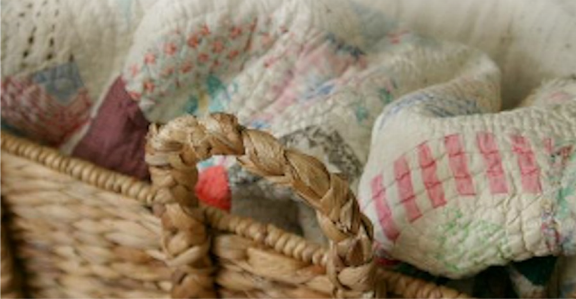
1. Vintage textiles have the past woven into their threads – the hands that stitched them, the people who used to wear them and even the rooms in which they were used. It’s a very personal history, full of domestic detail. If you’re lucky enough to find a handmade quilt at market, in a thrift shop or antique fair, then it’s worth snapping up even if it’s not in the best state of repair as it’s relatively easy to mend these items – or make them into new pieces if they’re beyond use for their original purpose.
2. Some of the fabrics used may be classics such as gingham, ticking or candy stripes and you can replace these without too much difficulty, but where other patches are torn or frayed you are unlikely to be able to match the pattern precisely. The most important thing is to find fabrics of the same weight and composition so they don’t pull or tear each other, and can be washed in the same way. Quilts and other patchwork items were made to be used, not displayed, so if you want to contribute to an item’s history, then don’t be afraid to add your own fabrics to the mix and let it evolve for future generations to enjoy.
3. Cut out damaged pieces by snipping the stitching around them very carefully with small sewing scissors that have sharp points. If there is quilting across the patch, cut through the quilting stitches too from the top of the quilt. Remove the patch so that you’re left with a hole in the patchwork (but not in the filling or backing). Cut a new piece of fabric (that has been preshrunk if you intend to wash your item in the future) and slip it inside the hole so that its edges are concealed. Slip stitch it neatly into place.
4. Replace any quilting stitches by hand, matching the quilting on the rest of the item. To prevent further damage to vintage fabrics, try to keep items away from strong sunlight which will cause them first to fade and eventually to simply rot away. If the worst comes to the worst and you have an item, a quilt perhaps, where parts are quite beyond repair, then don’t give up on the whole thing – cut out good sections to turn into cushions, or perhaps to frame and hang on the wall.
Do you have any other tips for working with vintage textiles? Comment below, we’d love to know!
*This article originally appeared in Bustle & Sew Magazine
Leave a Reply